|
|
I am interested in quantum trasnport and charge dynamics in two-dimensional systems.
I mainly use time-resolved transport measurements in the GHz and THz range for investigating ultrafast charge dynamics in semiconductors and 2D materials.
Achievements
|
|
Ultrafast Optical-to-Electrical Conversion Dynamics
(by on-chip THz spectroscopy)
Graphene is a promising materila for ultrahigh-bandwidth photo-detectors thanks to its zero bandgap nature.
In this work, we demostrate an ultrafast operating speed of 220 GHz by removing the current delay caused by the device structure and by using on-chip THz spectroscopy technology to read out the current with sub-picosecond time resolution.
Nature Photonics 16, 718 (2022).
|
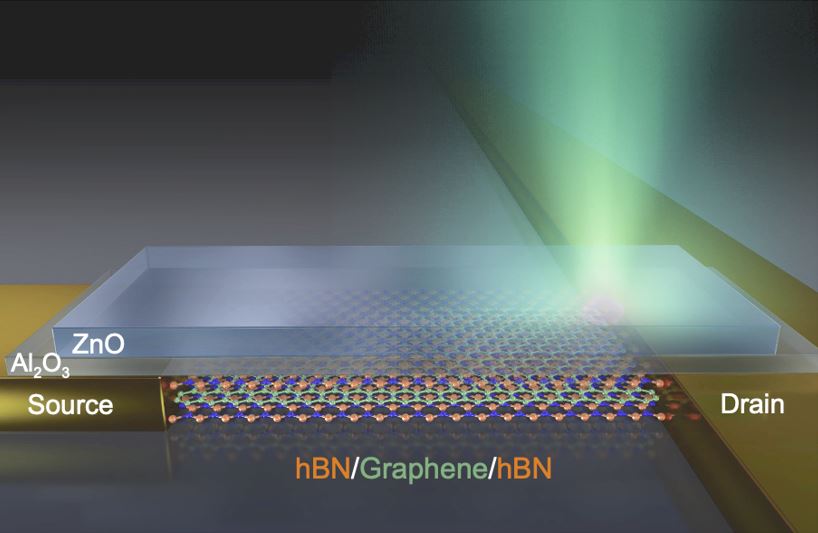
|
|
Active Spatial Control of Graphene Plasmons
(by THz spectroscopy)
Graphene offers the possibility for actively controlling plasmon confinement and propagation by tailoring its spatial conductivity.
In this work, we demonstrate full electrical control of plasmon reflection in graphene at electronic boundaries induced by a transparent patterned zinc oxide gate. This approach enables plasmons to be confined to desired regions.
Commun. Mater. 1, 7 (2020).
Related work: ACS Photon. 6, 947 (2019).
|
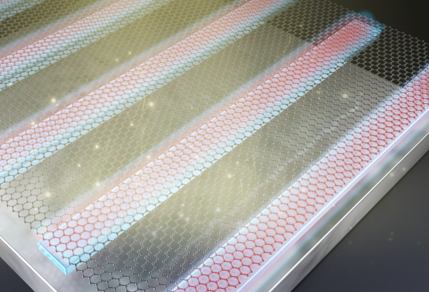
|
|
Charge Fractionalization in Artificial Tomonaga-Luttinger Liquids
(by high-frequency transport measurement)
We investigate charge fractionalizations in artificial Tomonaga-Luttinger liquids (TLLs) composed of two capacitively coupled quantum Hall edge channels (ECs) in graphene.
Using time-resolved transport measurements, we show that the fractionalization ratio and the TLL mode velocity vary with the interaction strength, following a unique function predicted by the TLL theory.
Phys. Rev. B 96, 081101(R) (2017).
Related work: Nature Nanotechnol. 9, 177 (2014).
|
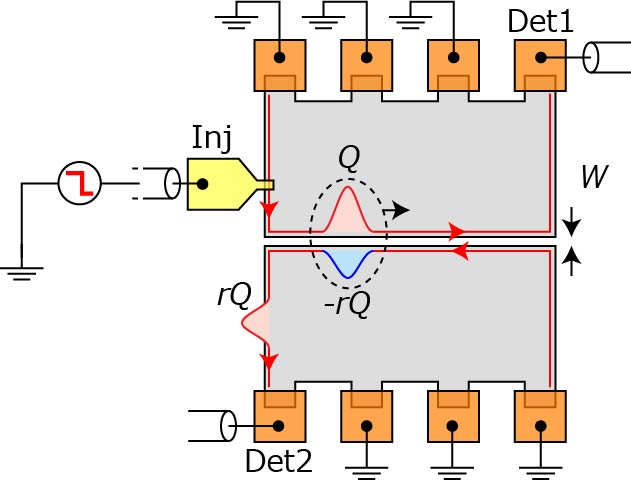
|
|
Shot Noise Generated by Graphene p-n Junctions in the Quantum Hall Effect Regime
(by shot noise measurement)
Graphene offers a unique system to investigate transport of Dirac Fermions at p-n junctions.
In a magnetic field, combination of quantum Hall physics and the characteristic transport across p-n junctions leads to a mixing of electron-like and hole-like modes and their subsequent partitioning. By measuring the shot noise generated by the mixing and partitioning process, we show that a graphene p-n junction could be used as an electronic beam splitter.
Nat. Commun. 6, 8068 (2015).
|
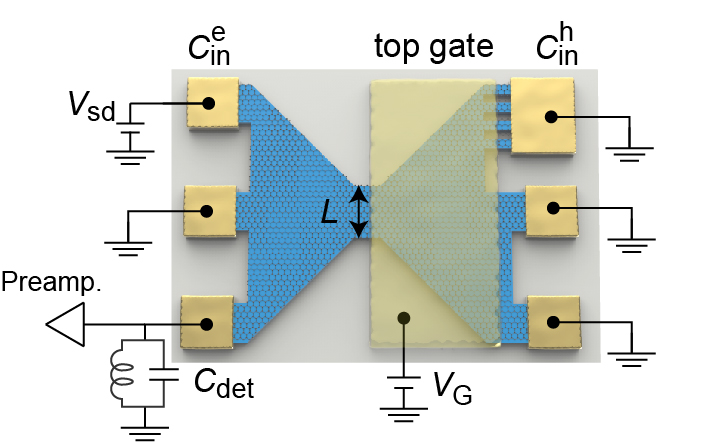
|
|
Edge Magnetoplasmons and Their Decay in Graphene
(by high-frequency transport measurement)
We investigate resonant edge magnetoplasmons (EMPs) and their decay in graphene by high-frequency (upto 50 GHz) electronic measurements. By frequency-domain measurement of EMP resonances in disk shaped graphene, we determine the dispersion relation of EMPs in graphene.
By time-domain measurement of the time evolution of EMP wavepackets, we identify extrinsic dissipation mechanisms.
Phys. Rev. Lett. 113, 266601 (2014).
|
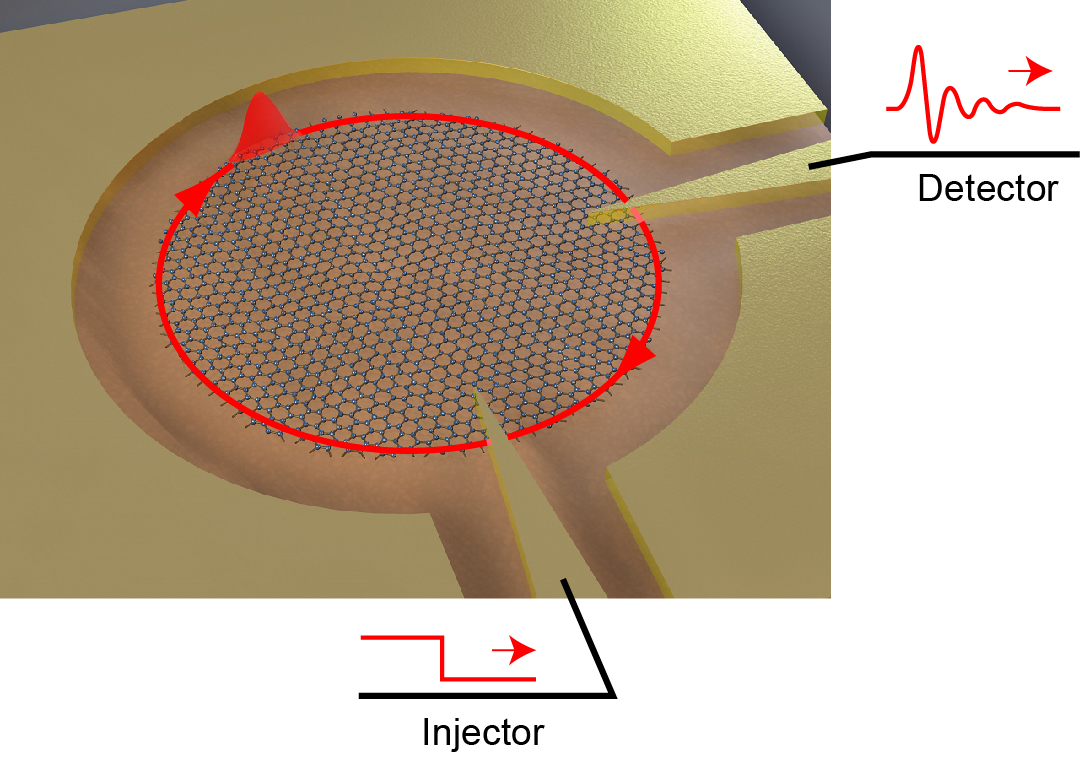
|
|
Tunable Edge Magnetoplasmons in Graphene
(by high-frequency transport measurement)
Graphene plasmonics have attracted interest, particularly because of the tunable plasmon dispersion. However, the carrier density dependence of the dispersion is weak (proportional to n1/4) and it is difficult to tune the frequency over orders of magnitude. Here, we demonstrate that the plasmon velocity can be changed over two orders of magnitude by applying a magnetic field and by screening the plasmon electric field with a gate metal.
Nat. Commun. 4, 1363 (2013).
Related work: Phys. Rev. B 84, 045314 (2011).
|
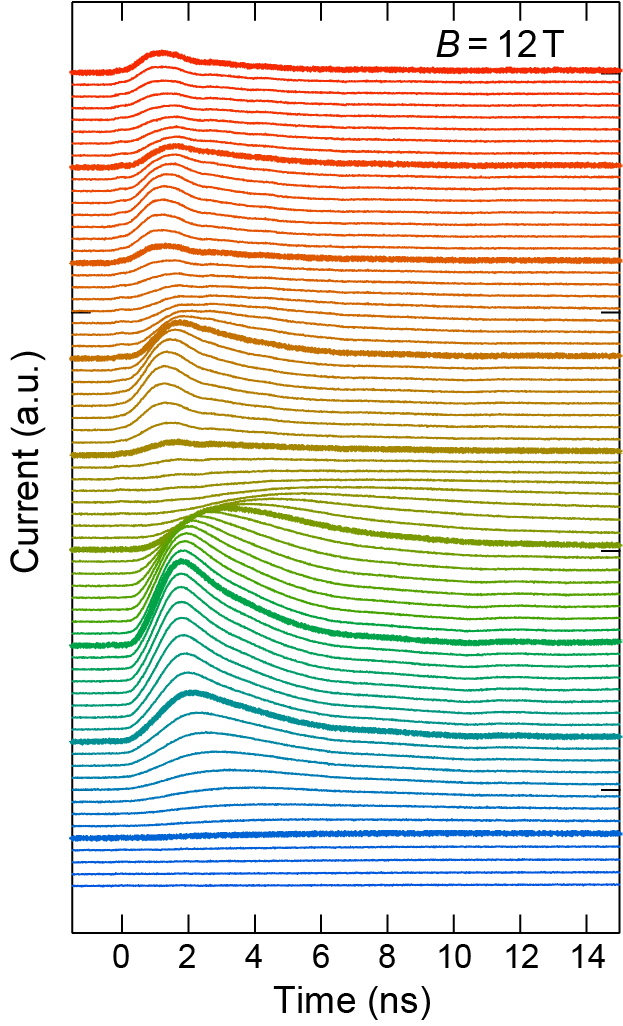
|
|
Unraveling the Spin Polarization of the nu = 5/2 Fractional Quantum Hall State
(by resistively-detected NMR)
The fractional quantum Hall (FQH) effect at filling factor ƒË = 5/2 has recently come under close scrutiny, as it may possess quasi-particle excitations obeying nonabelian statistics, a property sought for topologically protected quantum operations. Yet, its microscopic origin remains unidentified. Here we report direct measurements of the electron spin polarization of the nu = 5/2 FQH state. We find the system to be fully polarized, which unambiguously rules out the most-likely abelian contender and thus lends strong support for the nu = 5/2 state being nonabelian.
Science 335, 828 (2012).
|
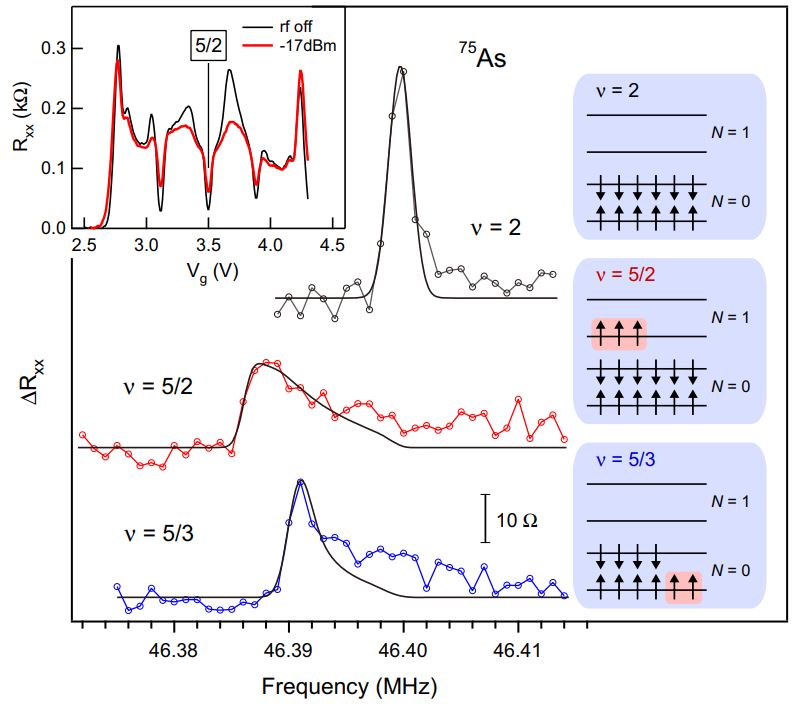
|
|
Electric Field Induced Nuclear Spin Resonance in GaAs-Based Semiconductors
(by resistively-detected NMR)
We demonstrate an alternative nuclear spin resonance using a radio frequency (rf) electric field instead of a magnetic field. It is based on the electronic control of electron spins forming a domain structure. The rf electric field applied to a gate excites spatial oscillations of the domain walls and thus temporal oscillations of the hyperfine field to nuclear spins.
Phys. Rev. Lett. 101, 137602 (2008).
|
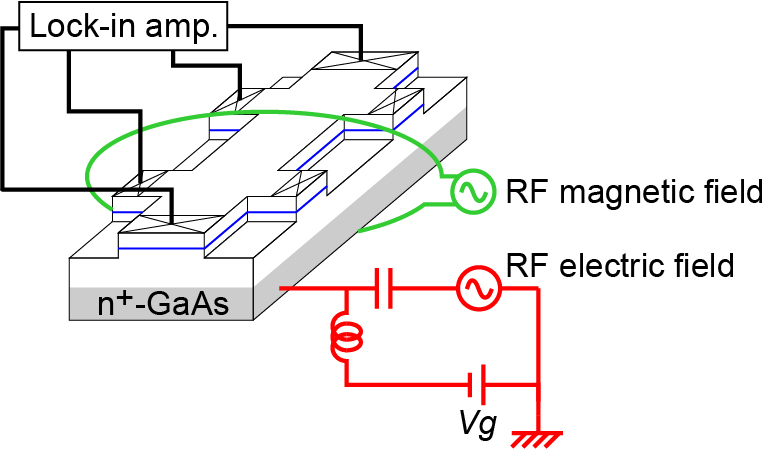
|
|
Subband-Landau-Level Coupling in Bilayer Quantum Hall States
(by transport measurement)
We study effects of tilted magnetic fields on energy levels in a double-quantum-well (DQW) system, focusing on the coupling of subbands and Landau levels (LLs). The subband-LL coupling induces anticrossings between LLs directly manifested in the magnetoresistance.
We also find that when the DQW potential is asymmetric, LL coupling occurs even within a subband.
Phys. Rev. B 77, 155324 (2008).
|
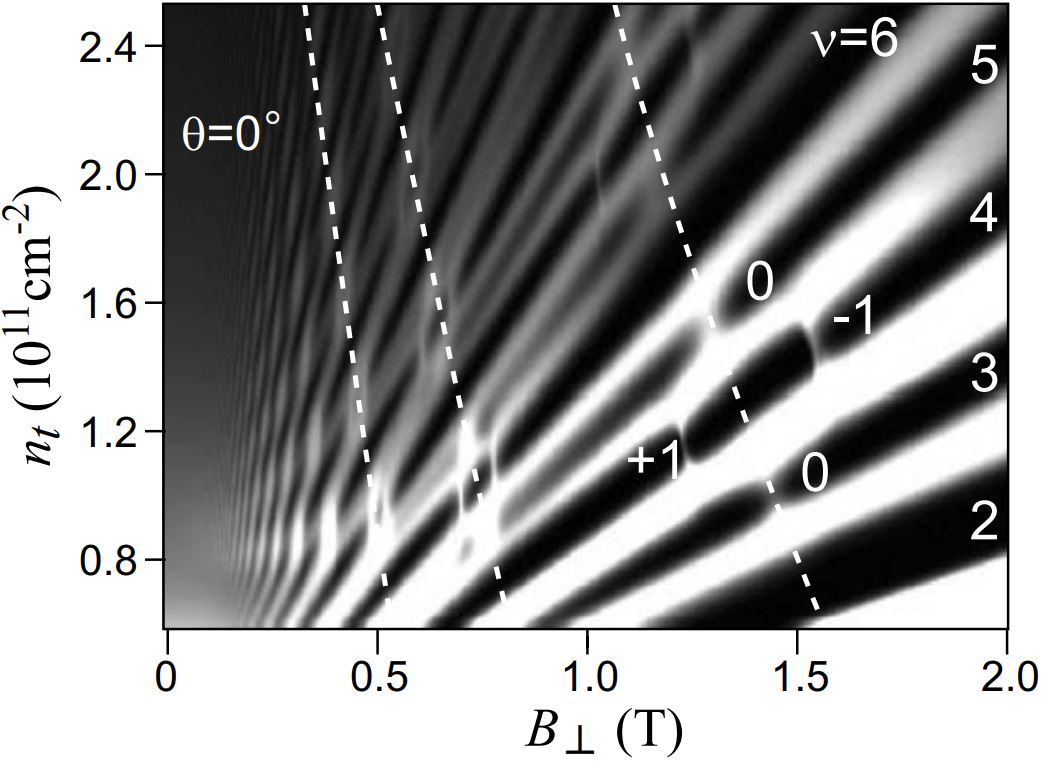
|
|
NMR Evidence for Spin Canting in a Bilayer nu=2 Quantum Hall System
(by resistively-detected NMR)
We investigate electron spin states in the bilayer quantum Hall system at total Landau level filling factor nu=2 by resistively-detected NMR. The measured Knight shift reveals continuous variation of the out-of-plane electronic spin polarization between nearly full and zero as a function of density imbalance. Nuclear spin relaxation measurements indicate a concurrent development of an in-plane spin component. These results provide direct information on the spin configuration in this system and comprise strong evidence for the spin canting.
Phys. Rev. Lett. 99, 076805 (2007).
|
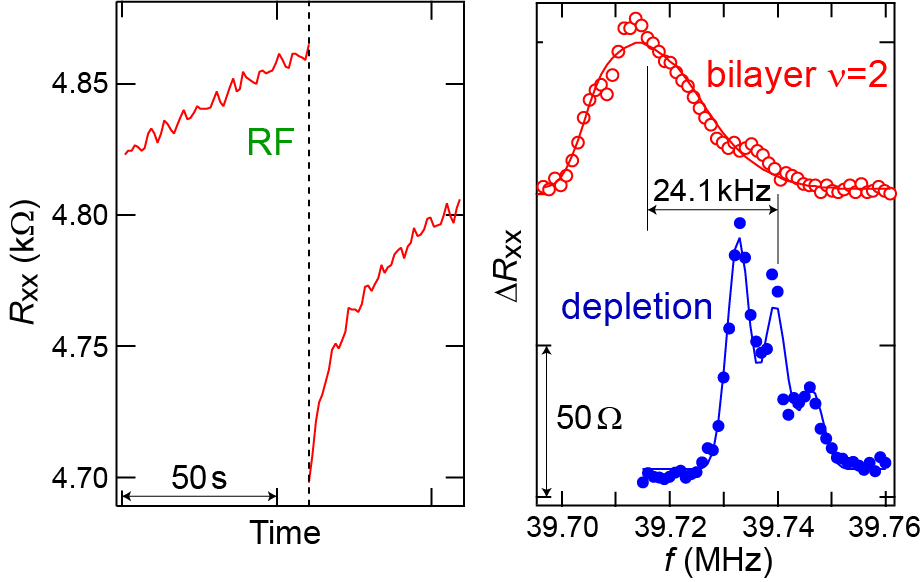
|
|
All-Electrical Nuclear Magnetic Resonance
(by resistively-detected NMR)
We study the nuclear spin population in a GaAs quantum well structure and demonstrate its initialization using an all-electrical nuclear magnetic resonance (NMR) device. In this device, nuclear spins are dynamically polarized in a submicron scale region defined by split gates. We find that nuclear spin populations are determined by electron spin configurations.
Appl. Phys. Lett. 90, 102118 (2007).
Related work: Appl. Phys. Lett. 91, 193101 (2007).
|
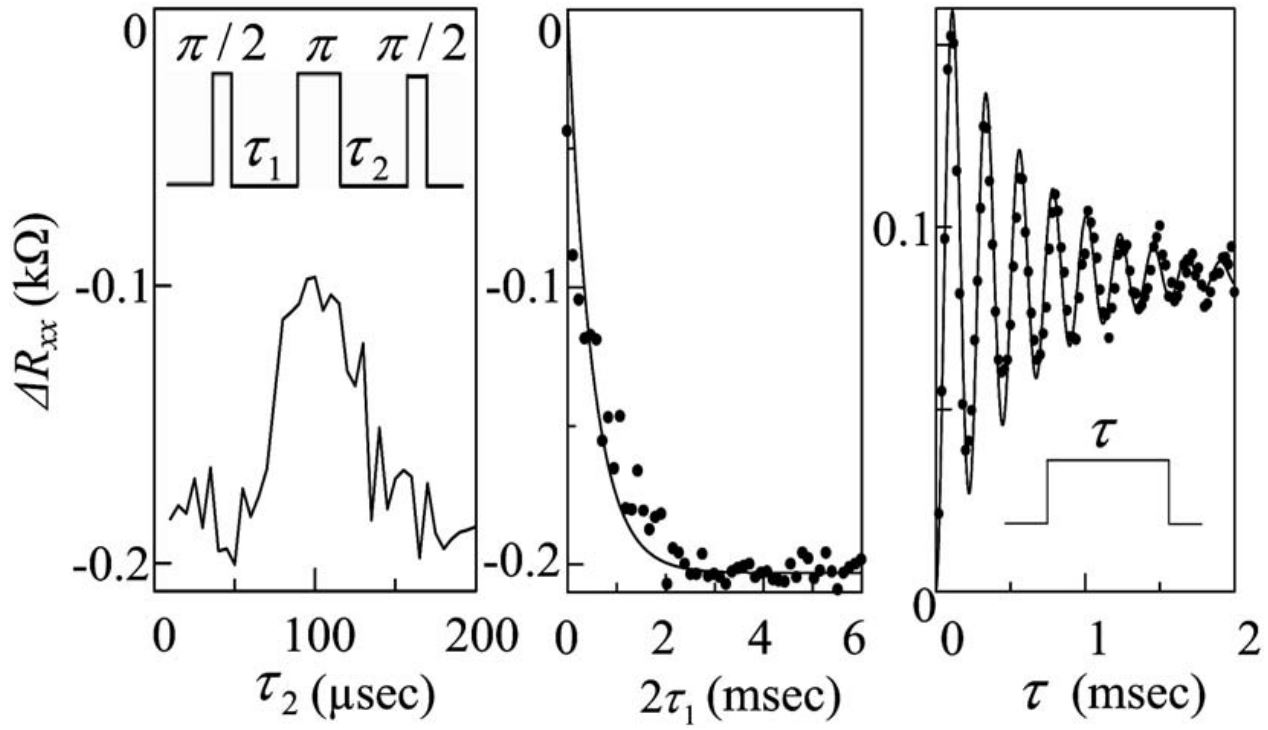
|
|
Low-Frequency Spin Dynamics in a Canted Antiferromagnet
(by resistively-detected NMR)
Resistively detected nuclear spin relaxation measurements in closely separated two-dimensional electron systems reveal strong low-frequency electron-spin fluctuations in the quantum Hall regime.
Our data demonstrate the realization of a two-dimensional system with planar broken symmetry, in which fluctuations do not freeze out when approaching the zero temperature limit.
Science 313, 329 (2006).
|

|
|
Spin Degree of Freedom in the nu=1 Bilayer Electron System Investigated by Nuclear Spin Relaxation
(by resistively-detected NMR)
We investigate electron spin fluctuations around nu=1 in a bilayer quantum Hall (QH) system.
The measured 1/T1 is found to increase gradually from the QH state at low fields through a phase transition to the compressible state at high fields.
Our result demonstrates that, as opposed to common assumption, the electron spin degree of freedom is not completely frozen in the nu=1 QH state.
Phys. Rev. Lett. 94, 096802 (2005).
Related works:
Phys. Rev. Lett. 100, 106803 (2008).
Phys. Rev. Lett. 104, 056802 (2010).
|
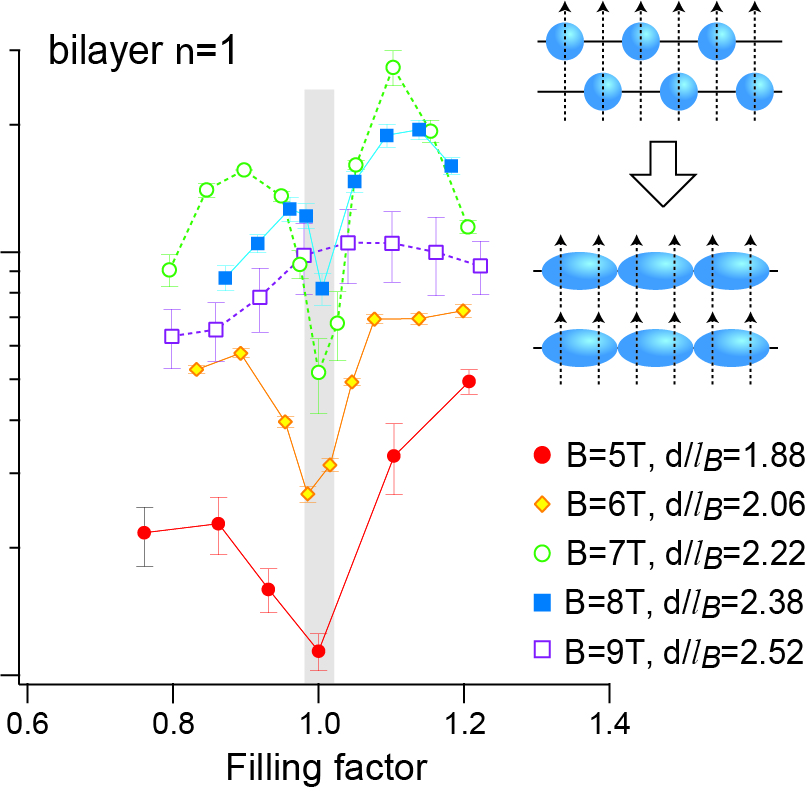
|
|
Phase Diagram of Interacting Composite Fermions in the Bilayer nu=2/3 Quantum Hall Effect
(by transport measurement)
We study the phase diagram of composite fermions (CFs) in the presence of spin and pseudospin degrees of freedom in the bilayer nu=2/3 quantum Hall (QH) state.
While a noninteracting CF model provides a qualitative account of the phase diagram, the observed renormalization of tunneling gap and a non-QH state at high densities are the manifestations of interactions between CFs.
Phys. Rev. Lett. 89, 116802 (2002).
Related work: Phys. Rev. B 69, 155319 (2004).
|
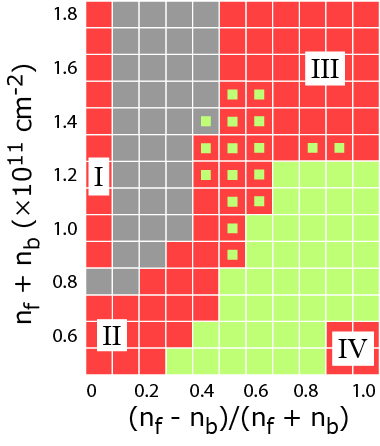
|
|
Doubly Enhanced Skyrmions in a Bilayer Quantum Hall State
(by transport measurement)
We compare skyrmion excitations in the bilayer quantum Hall (QH) state at the Landau-level filling factor nu=2 and in the monolayer QH state at nu=1.
The observed number of flipped spins, N_spin, is 14 in the bilayer QH state, while N_spin=7 in the monolayer QH state.
The difference is interpreted to be due to the interlayer exchange interaction.
J. Phys. Soc. Jpn. 69, 3178 (2000).
|
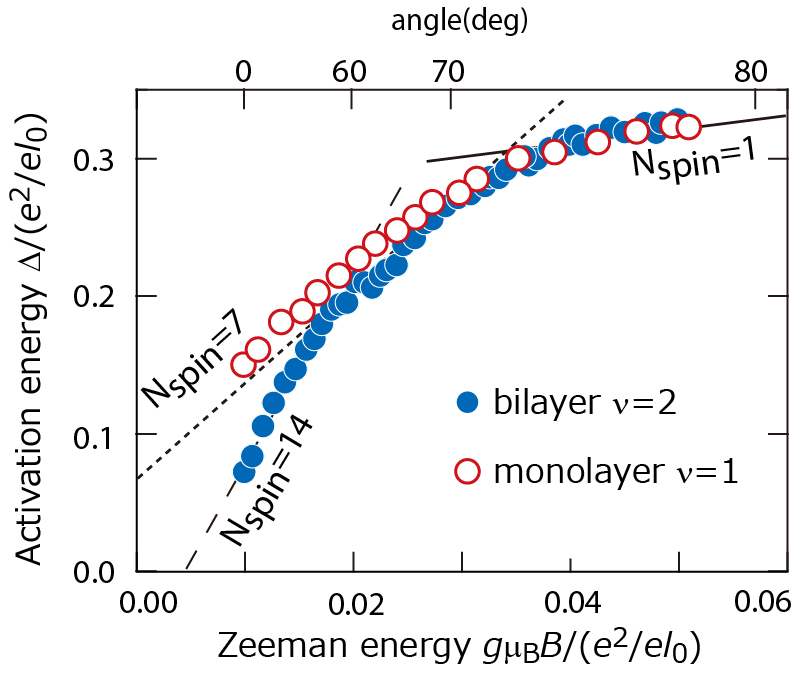
|
|